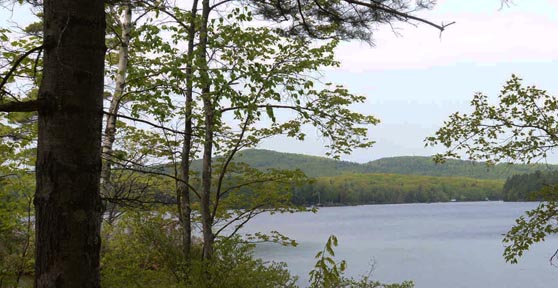Coming up to Deering on Route 149 from Hillsborough, just past the cemetery at Clement Hill Road, on the left, you will see a very tall tree among other very tall trees that is just loaded with white flowers. A little further along on Deering Center Road, on the right, are a few smaller white-flowered trees. There is another really grand specimen of this same tree on Rt 9 heading into Concord at Currier Road. These are Northern Catalpa, Catalpa speciosa, and now is its time to bloom.
The exuberance of the blossoms of this tree, the mountain of white almost baroque flowers, seem out of place, here in flinty, cold, puritanical New England. But, here they are! And at least one of them has been in Deering for a very long time.
Northern Catalpa is thought to be native to the mid-west, the Arkansas and Illinois region. The species was introduced into New England late in the 19th Century as a shade tree in big Victorian estates. There was never a big Victorian estate at the location of Deering’s big Northern Catalpa, at the intersection of Clement Hill Rd and Deering Center Rd. I think it is on land that was owned by an early Deering settler, L. Otis, and may be the lot owned much later by John and Mary Herrick. The Herricks took up residence in Deering in 1917 at a place described as ‘the house by the side of the road at Route 149 and Clement Hill Road, formerly owned by the Otises.’ The Herricks were crafts people who were renowned for their work in pewter, silver and semiprecious stones (including garnets, quarts, crystals, and amethyst found in nearby stone walls). They were said to guard a secret formula for preparing cattails for reed chair seats.
Northern Catalpa trees are fast growing and can attain 40 – 60 feet in height and an age of 50 – 150 years (thus it is at least possible that the Herricks planted this tree early in the 20th Century). In New England the tree only occurs in garden settings in full sun; it is not known to be a forest tree. It can withstand a wide variety of soil conditions. The fruit is a bean-like pod that can reach 15 inches in length; it splits open to discharge seed. Sometimes the tree is called ‘cigar tree’ because of the fruit.
The big Northern Catalpa at the intersection of Clement Hill and Deering Center Roads has a trunk circumference of 105 inches (the circumference of the Hillsborough County champion Northern Catalpa, in Lyndeborough, is 156 inches). Catalpa did not appear in the 1980 or 1985 lists of big trees found in Deering.
Northern Catalpa is unusual in that its flowers are pollinated by bees during the day and by moths at night. Bees are attracted by the yellow and purple ‘nectar guides’ in the flowers, and moths are attracted by increased nighttime nectar production.
Catalpa is a genus of the family Bignoniaceae. It is not related to Bigonia, which is a member of the family Bigoniaceae. Catalpa is the northernmost member of the family. The Bignoniaceae is largely a tropical family, where it is represented by gaudily flowering vines and trees. A second species of Catalpa occurs as an ornamental in New England. Southern Catalpa, C. bignonioides, is a smaller tree that has smaller leaves and the leaves, when crushed, are said to have an unpleasant odor. The Southern Catalpa also flowers later than its northern cousin. Although Southern Catalpa is not supposed to be found in New Hampshire, there a big, old Catalpa in the North Weare Cemetery, on Route 149, that is not yet flowering; its leaves have at least a ‘funky’ odor that some might find unpleasant. It is likely to be Southern Catalpa








